March 29, 2008
Moving Tintin
I helped Tintin move today. The person she had been renting a room from had her daughter and son-in-law move in because they're pregnant and so they need the room again. So Tintin moved into a room at a different house nearby, still in East San Jose. She doesn't have too much stuff so it wasn't bad. But I did end up breaking her mirror by accident.
Tintin's parents also showed up later to help, at the new place. It took them a long time to drive up, so it was good we had most everything in her new room already. They treated me to lunch at a Phở place nearby which was yummy.
Posted by josuah at 10:47 PM UTC+00:00 | Comments (0) | TrackBack
March 24, 2008
Trane XV95 + XL15i
After suffering through incredibly hot summers, I've finally installed central air conditioning and a new high efficiency furnace. I ended up picking Allied Aire based on their quote and professional service; they were recommended to me by Paul.
The Trane XV95 is their newest and most efficient two-stage variable-speed furnace, although the low speed is only available when heating, and their top of the line model. The XL15i is not their top of the line model but very efficient without increasing the cost too much.
Now I just need to replace or re-insulate the doorways to finish making the home environmentally comfortable. The rear windows should get replaced sometime too because they are not airtight and sometimes water can get through their weep holes or condense on them too.
Posted by josuah at 5:32 PM UTC+00:00 | Comments (0) | TrackBack
March 8, 2008
Bloodrayne
Shortly after BloodRayne came out, I read all sorts of horrible reviews about it. People condemned Uwe Boll as worst director of all time and wondered how he could get funding in the face of his failure, and who in their right mind was willing to fund his future directorial works. When you read things like this, you can't be entirely sure if people are just being too hard on something or someone, or if it's sort of just a bandwagon sort of thing. But in this case, everything you'll read is right.
Cast a handful of excellent actors in character roles that are completely shallow, mix with a composer who doesn't realize the music must follow the movie, throw in one version of every scene you thought was cool when you were 10-years-old, and then cut corners on anything that will cost money. And don't forget the obligatory sex scene since your star is considered a sex symbol. That's pretty much what you'll experience with this movie. Oh, and the plot sucks too.
Posted by josuah at 7:25 AM UTC+00:00 | Comments (0) | TrackBack
March 7, 2008
Desert Punk
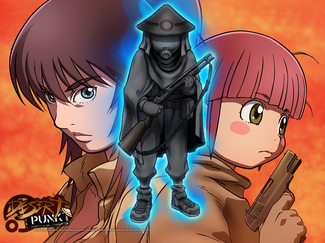 Sunabozu is an anime that is crude and unapologetic about it. In the Kanto desert, life is harsh and cheap. A catastrophe from long ago left the world barren and lifeless. Knowledge of the old technologies has been lost, and great metropolises are ruins. The Sunabozu, or Desert Punk, is the greatest handyman in the Kanto desert. Handymen are basically people you can hire to do just about whatever you want. His extreme cunning and skill with the shotgun has created a legend. But he's also an extremely horny and selfish boy; any beautiful girl turns him into a drooling idiot, especially if she has big ones.
Sunabozu is an anime that is crude and unapologetic about it. In the Kanto desert, life is harsh and cheap. A catastrophe from long ago left the world barren and lifeless. Knowledge of the old technologies has been lost, and great metropolises are ruins. The Sunabozu, or Desert Punk, is the greatest handyman in the Kanto desert. Handymen are basically people you can hire to do just about whatever you want. His extreme cunning and skill with the shotgun has created a legend. But he's also an extremely horny and selfish boy; any beautiful girl turns him into a drooling idiot, especially if she has big ones.
Sunabozu's nemesis is Asagiri Junko, a skilled beauty who Sunabozu lusts after but who always seems to get the best of him. His sidekick is the Kosuna, a 14-year-old girl who desires to become the Kanto desert's most skilled beauty. She has some work cut out for her, dealing with Sunabozu and Junko. A number of other regular characters show up along the way.
The series is sort of split into halves. The first half is a bunch of random handyman missions that establishes the setting and the characters. These episodes stand alone and their primary entertainment value is on the humor, which is often crude and leaning towards the fantastical or slapstick. The second half launches into a political struggle between two different factions who have differing opinions on the direction things should be taken. It's during these episodes that a plot forms and the characters begin having to face more serious issues.
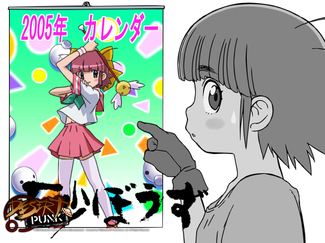 My favorite character would have to be Kosuna. And I really like her seiyu, Chiwa Saito. Her voice is young, energetic, and fits Kosuna perfectly. Plus, she is able to pull of a really cool monkey laugh that is a huge part of Kosuna's personality.
My favorite character would have to be Kosuna. And I really like her seiyu, Chiwa Saito. Her voice is young, energetic, and fits Kosuna perfectly. Plus, she is able to pull of a really cool monkey laugh that is a huge part of Kosuna's personality.
The artwork is very nice as well. Although I don't really like when they draw male faces all scrunched up and weirded out in order to show strange and extreme expressions. They never end up doing that on the female faces—they always look nice.
Unfortunately, Luna tells me that the series was forced to end early because it wasn't popular enough. I did feel a little disappointed by the ending because just as lines were being drawn and a story of epic conflict being built up, it comes to a conclusion. The future is left open and you never find out what will really happen. Still, seeing Kosuna grow up and watching the interplay of her, Sunabozu, and Junko is interesting.
One word of warning: the English ADR is completely changed from the original Japanese. So you'll be hearing a whole different set of conversations if you watch it dubbed.
Posted by josuah at 3:46 AM UTC+00:00 | Comments (0) | TrackBack
March 4, 2008
Woman on the Edge of Time
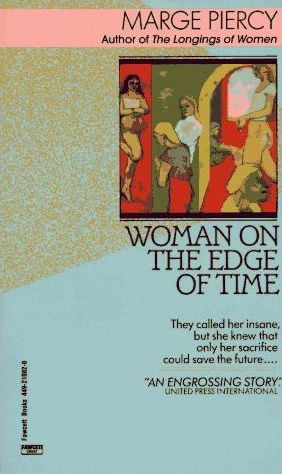 Calvin gave me Woman on the Edge of Time, by Marge Piercy, for a birthday gift. It was written in 1976 and features a world set at that time, seen through the eyes of a poor disenchanted Hispanic woman living in the slums of New York City. Consuelo, the narrator of this novel, wonders if she is going crazy because she begins seeing and talking to a man who claims to be from the future. She ends up in a psychiatric ward for other reasons, and comes to believe that there is a utopian future that runs a risk of not happening, depending on what she can do in the present day.
Calvin gave me Woman on the Edge of Time, by Marge Piercy, for a birthday gift. It was written in 1976 and features a world set at that time, seen through the eyes of a poor disenchanted Hispanic woman living in the slums of New York City. Consuelo, the narrator of this novel, wonders if she is going crazy because she begins seeing and talking to a man who claims to be from the future. She ends up in a psychiatric ward for other reasons, and comes to believe that there is a utopian future that runs a risk of not happening, depending on what she can do in the present day.
There are several layers to this book. At one level, this is a book that looks at and criticizes the treatment of and attitudes towards people who have been deemed by the rest of society as crazy. Piercy depicts a situation, based on reality, where these psychiatric patients are treated more like laboratory animals and sub-human creatures undeserving of consideration. This is also seen in the racial segregation between Caucasians and Hispanics. Consuelo lives in a world where she is ugly, poor, and must suffer the whims of those in power. Those in power are the white men and women who run the world and they are rich and beautiful, living with control over their own lives.
Another layer is brought out in the presentation of this utopia that Consuelo learns of and begins to love. In this future, her child is reborn carefree and loved instead of poor and stolen away. People live close to the earth, as large extended families who share material goods and love freely. It is a world where anyone can do what they wish, and both physical and mental illness are completely understood and easily cured. No one is wanting, although at the same time no one wants. It's both attractive and at the same time does not seem right. Idealistic but not at all realistic. But then they've figured out how to breed out the qualities they consider harmful.
Lastly there is a question of belief. It's never clear whether or not Consuelo is actually imagining things, or if she really is able to travel through her mind to the future and live there among those people as if she were there in physical form. The copy on the back of my book implies her experiences are real, but in truth the novel does not. If it is the truth, then calling her crazy and locking her up could be the worst thing for all of us. If it isn't the truth, then she really is crazy and probably needs to be there. How can you ever know?
Posted by josuah at 4:25 AM UTC+00:00 | Comments (0) | TrackBack
March 2, 2008
Ghost in the Shell: Solid State Society
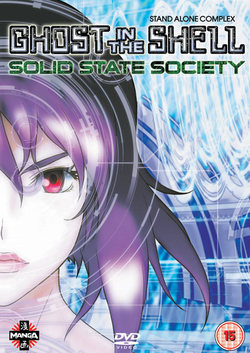 Ghost in the Shell: Solid State Society takes place in the story line created in the Stand Alone Complex television series featuring Section 9. In those two years since The Laughing Man and The Individual Eleven incidents, Section 9 has changed. Motoko has left and is pursuing her own goals, and Section 9 is expanding which puts Togusa and Batou into teaching roles for a number of new recruits. The movie begins with a series of suicides somehow linked to a terrorist organization. All signs point to a hacker who is causing these suicides and has some overarching plan concealed by these inexplicable suicides. Motoko's role in these events is unclear, as she shows up at opportune times without providing an explanation.
Ghost in the Shell: Solid State Society takes place in the story line created in the Stand Alone Complex television series featuring Section 9. In those two years since The Laughing Man and The Individual Eleven incidents, Section 9 has changed. Motoko has left and is pursuing her own goals, and Section 9 is expanding which puts Togusa and Batou into teaching roles for a number of new recruits. The movie begins with a series of suicides somehow linked to a terrorist organization. All signs point to a hacker who is causing these suicides and has some overarching plan concealed by these inexplicable suicides. Motoko's role in these events is unclear, as she shows up at opportune times without providing an explanation.
This film appears to be commenting on social issues possibly facing Japan today, and the world as a whole to some degree. There is a growing class of elderly who require care but are not productive member of society. The birth rate in developed countries is declining as people focus on careers and couples decide not to have children. It can be very difficult to address these issues, because in a lot of cases the solutions run counter to individual desires or current socially acceptable policies and moral ideas.
The question is really whether or not doing the right thing is really what's best for us all in the long run.
Posted by josuah at 8:55 PM UTC+00:00 | Comments (0) | TrackBack
Ghost in the Shell 2: Innocence
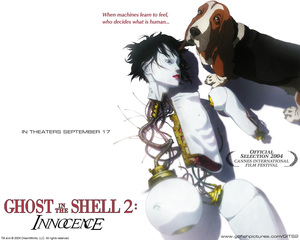 Ghost in the Shell 2: Innocence continues the story line that began in the original Ghost in the Shell and was also directed by Mamoru Oshii. You do need to have watched the first movie to fully appreciate the second, as it provides background into the characters and establishes the backstory. There are a lot of parallels in the presentation between the two films as well.
Ghost in the Shell 2: Innocence continues the story line that began in the original Ghost in the Shell and was also directed by Mamoru Oshii. You do need to have watched the first movie to fully appreciate the second, as it provides background into the characters and establishes the backstory. There are a lot of parallels in the presentation between the two films as well.
This time the story's primary character is Batou, as Motoko is unavailable after the events of the first movie (trying to avoid a spoiler). He and his partner Togusa are investigating a case of gynoids, or human-like robots with AI, that are murdering their owners. Their investigation leads them to a criminal operation or horrific proportions.
If you liked the first film, you should like this one. However there is a heavier requirement on thinking and deductive reasoning this time. In the first film, a lot of the ideas and questions were discussed outright. In Innocence, the ideas are presented through the plot, like in the first film, but not as much time is spent actually speaking out the implications of those ideas. And for some of them you'll really need to try and figure it out on your own; waiting for the explanation will cause you to miss the significance of what you just saw.
The visual capabilities have greatly improved in the past several years, giving Innocence a more polished look. The animation itself is also more fluid and animated than before, as it was done using cel shaded models rather than hand drawings. I think the same composer came back to do the score, and the sound is very similar to the first film although this time 5.1 was the original production goal. I don't like it as much as Yoko Kanno's work, but it's still good.
Unfortunately, it seems like the disc copy I picked up is of an older release that contains closed-captions style English subtitles.
Posted by josuah at 6:57 AM UTC+00:00 | Comments (0) | TrackBack
Avalon
Avalon is interesting, but it's slow. Directed by Mamoru Oshii, it's no surprise that there are a lot of deep thoughts and questions about life, reality, and ones perception of the world. However it requires the viewer to work hard at paying attention, as it can't keep you there on its own.
The world is in some sort of post apocalyptic era, where fresh food and studio apartments are considered a luxury. It's not really clear what the world is like, as everything in the film focuses on the game, which is a VR first-person-shooter of incredible reality. Ash, the protagonist, is exceptionally good at this game, and is trying to find some way to finish it; to get to the final level. Over time it becomes clear there's something unique about getting that far, and that only makes her want it even more.
Oshii is an excellent director, and there is a lot to take in from the film. The environments, backgrounds, and every detail contributes in some small way. Near the climax, I really found myself anticipating what would happen next, hoping to find an answer. And in that sense it was satisfying. However I wish the journey had been a little more enjoyable.
Posted by josuah at 6:56 AM UTC+00:00 | Comments (0) | TrackBack
Ultraviolet
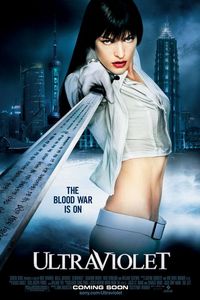 I didn't hear good things about Ultraviolet, even though I tend to like movies starring Milla Jovovich. It was written and directed by Kurt Wimmer, who also wrote and directed the amazing Equilibrium, and knowing that now I find it disappointing that Ultraviolet is in almost every way a the same story of Equilibrium, except without the emotional strength, inner conflict, and excellent choreography.
I didn't hear good things about Ultraviolet, even though I tend to like movies starring Milla Jovovich. It was written and directed by Kurt Wimmer, who also wrote and directed the amazing Equilibrium, and knowing that now I find it disappointing that Ultraviolet is in almost every way a the same story of Equilibrium, except without the emotional strength, inner conflict, and excellent choreography.
A lot of the same symbolism is used throughout, with the church and religion and big brother. The same scenes are used as well, with very similar rooms and types of action sequences. But the action sequences are horrible. In Equilibrium people with guns could actually aim. In Ultraviolet, the police don't seem to know how to point a gun at something a dozen feet away, and are so stupid they don't shoot even when Violet's basically harmless. I do like the overall feel of the movie, and its imagery, style, and use of color. There were some nice special effects as well.
But it's still a rehash of Equilibrium, which is a movie better by orders of magnitude.
Posted by josuah at 12:17 AM UTC+00:00 | Comments (0) | TrackBack

 Nami & Kiba - Away From Home
Nami & Kiba - Away From Home Goodbye Ellie
Goodbye Ellie Evangelion Mini Cooper S Clubman
Evangelion Mini Cooper S Clubman Married to Christina
Married to Christina